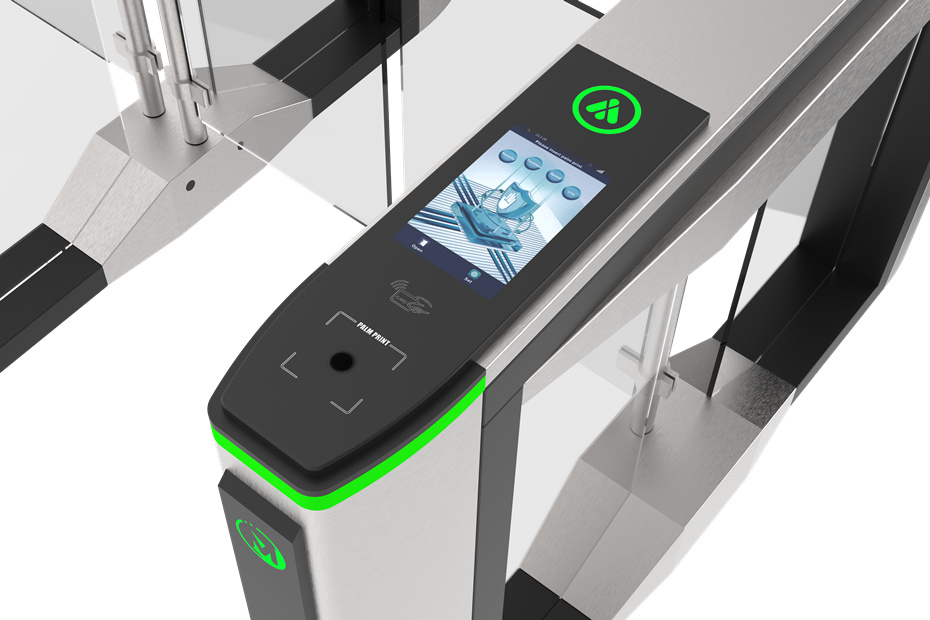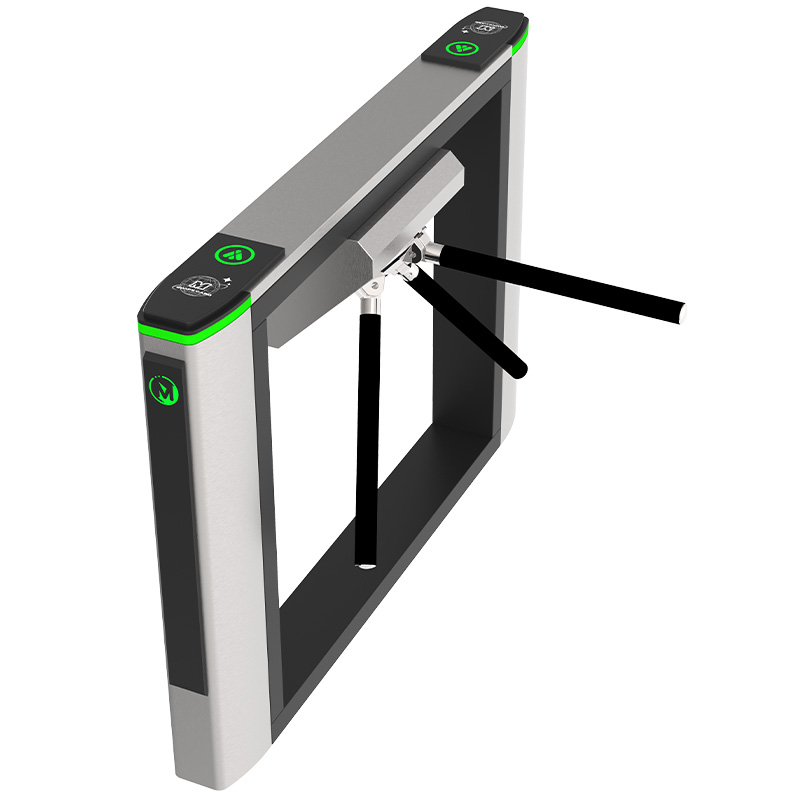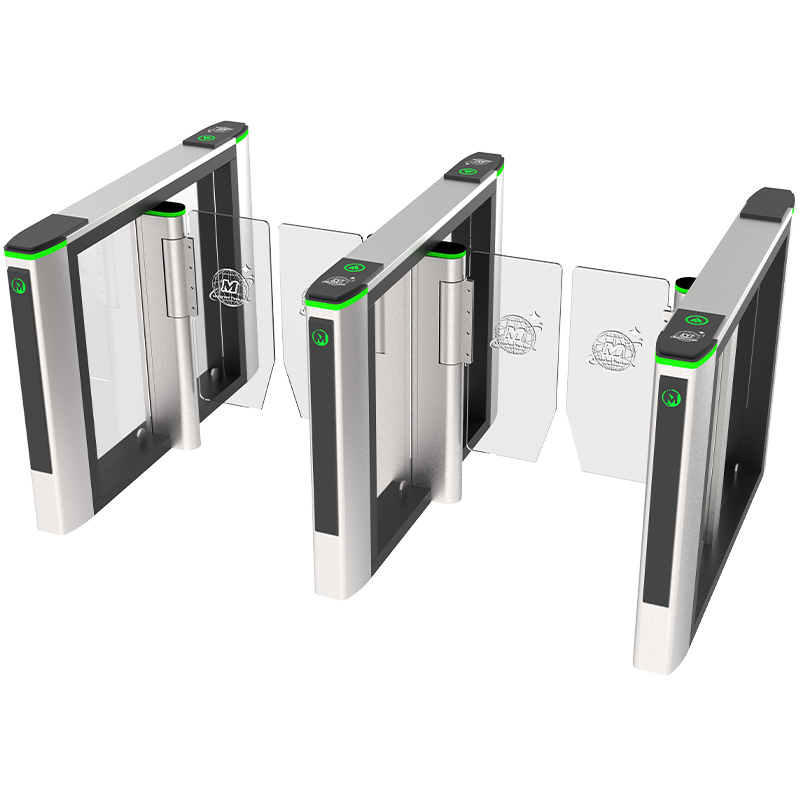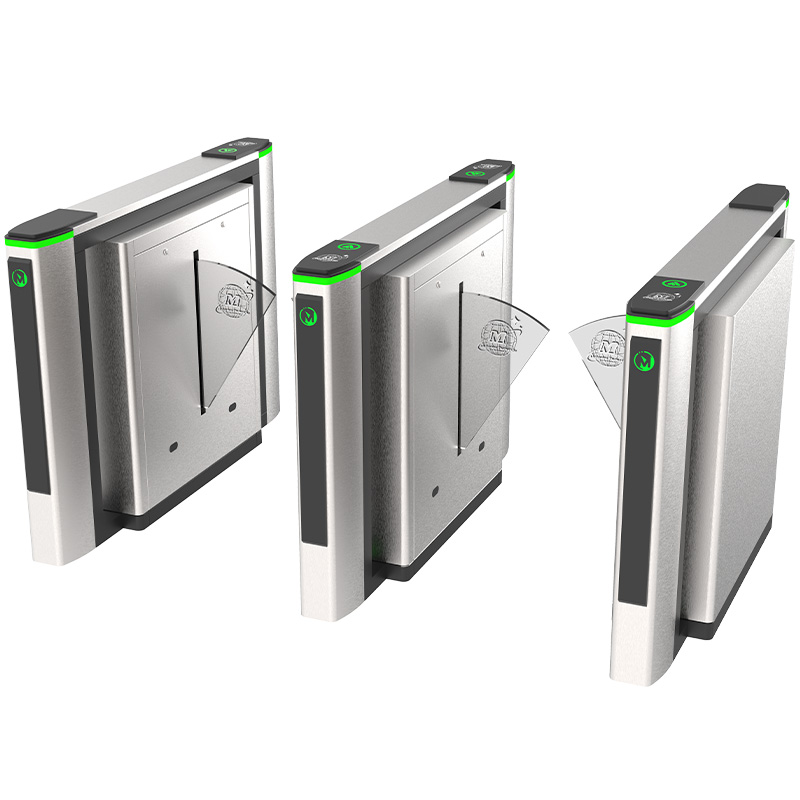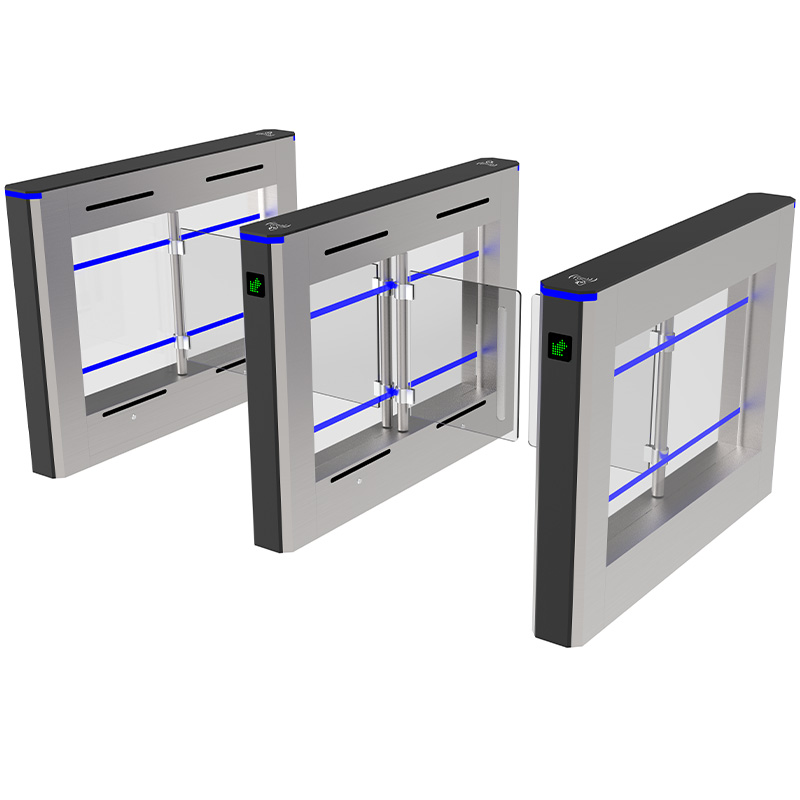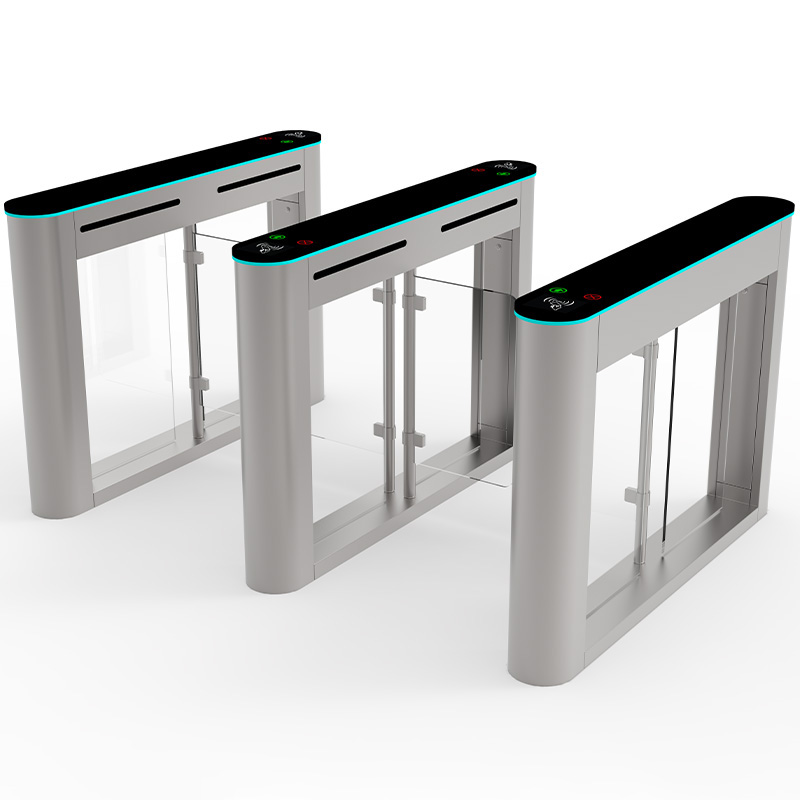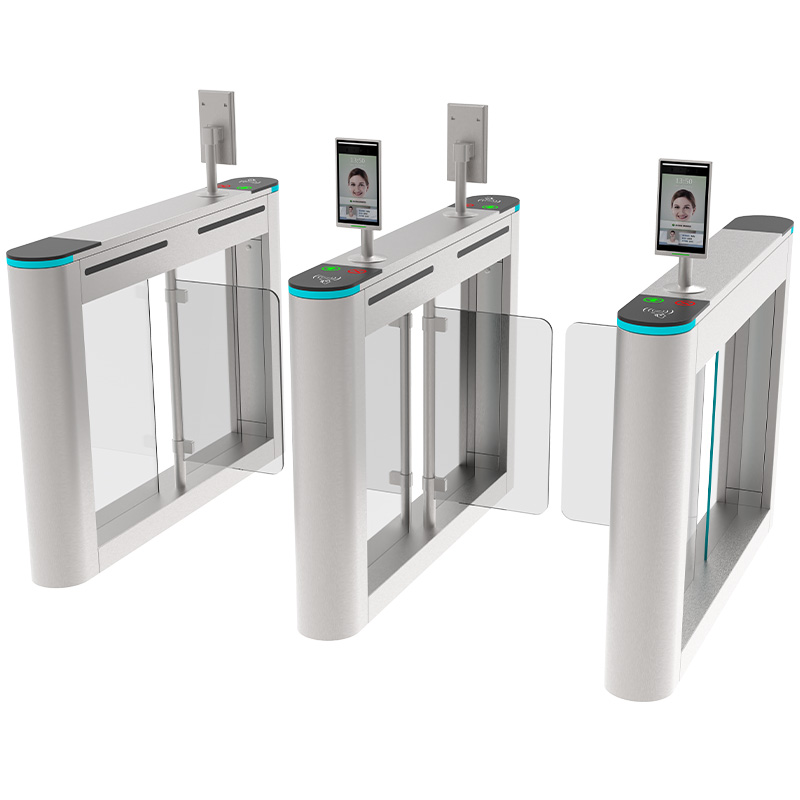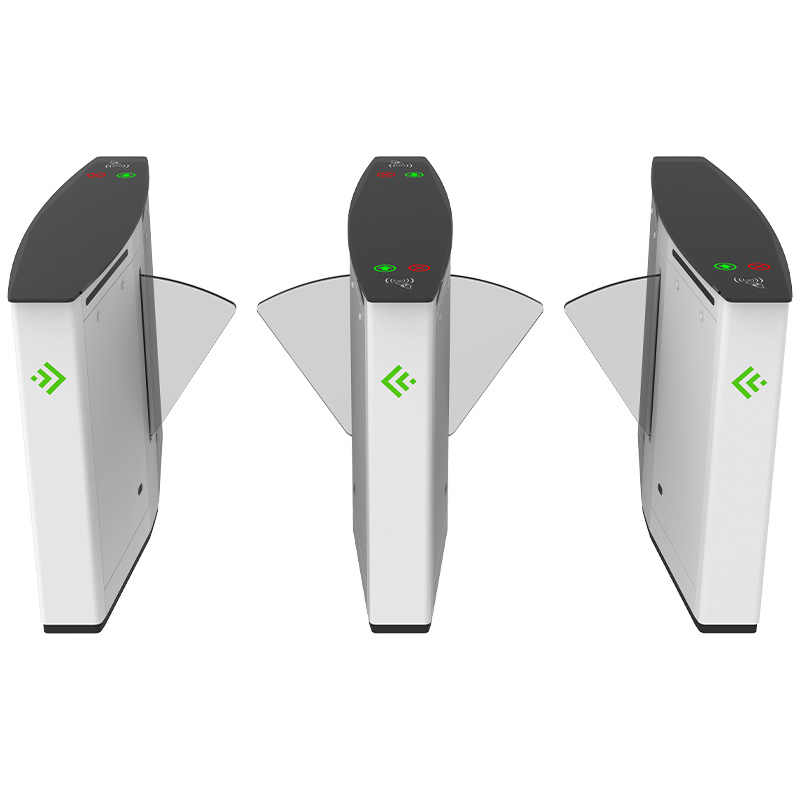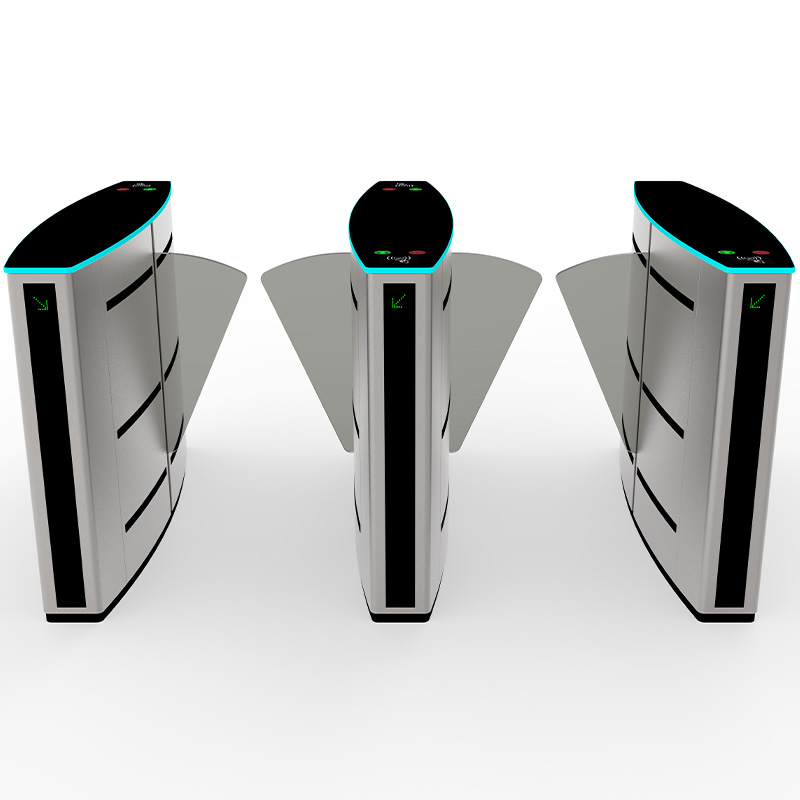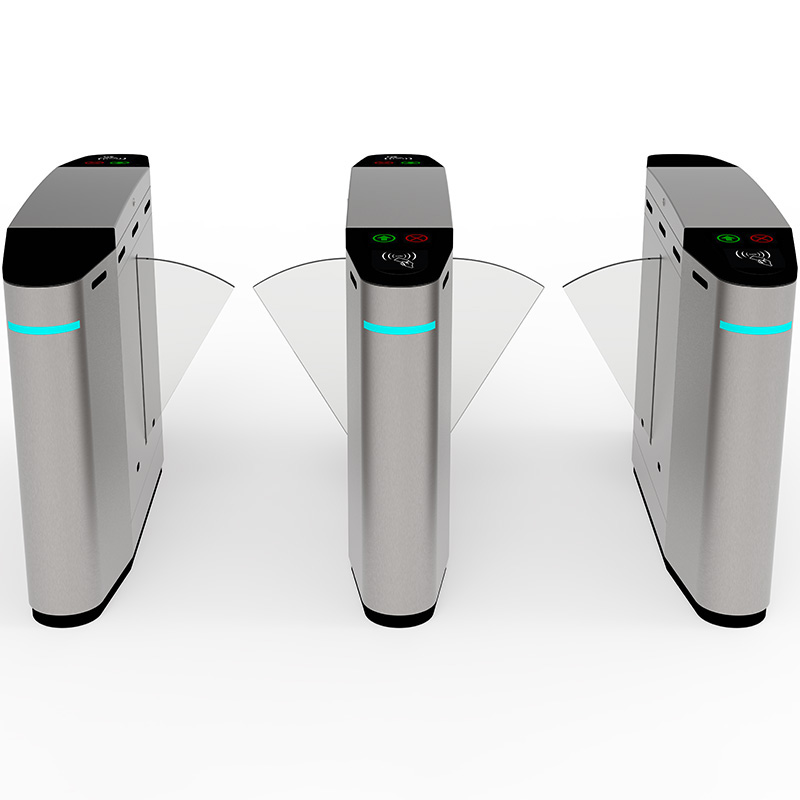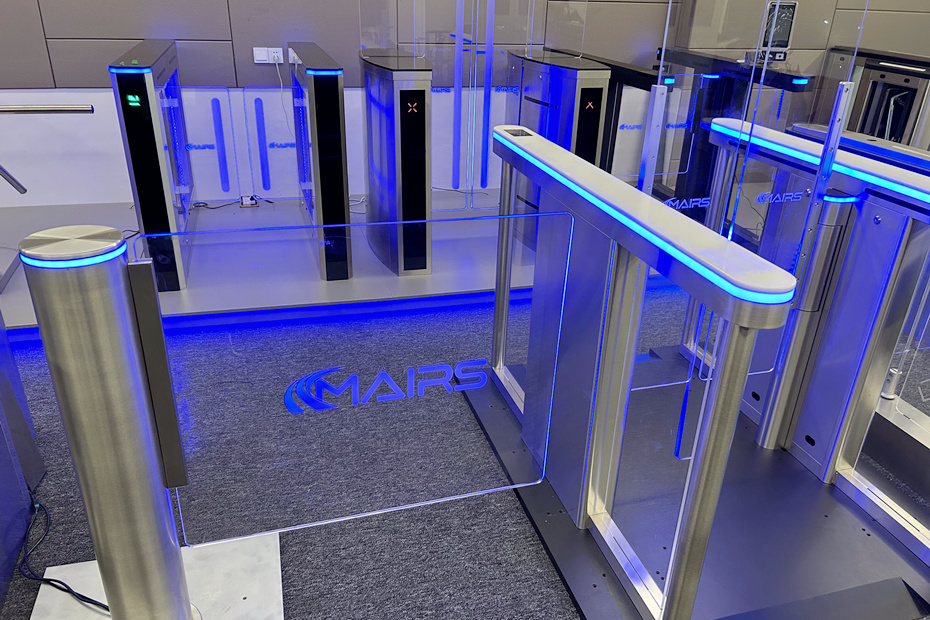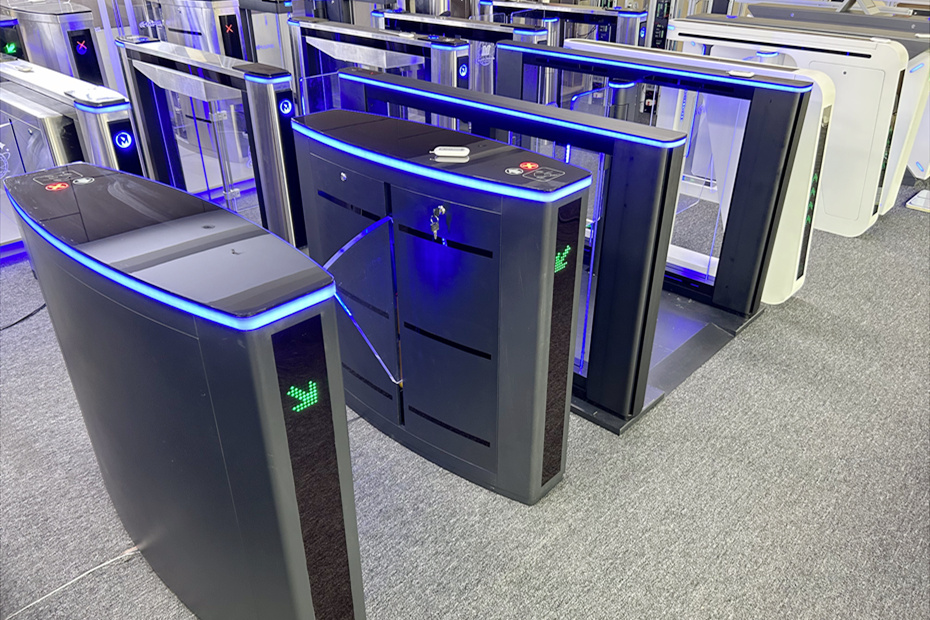Last updated on: December 20th, 2024 12:50 pm
What is a biometric turnstile?
Biometric turnstile is a type of pedestrian turnstile gate that uses biometric technology to verify passage. It usually has enough space to easily integrate biometric devices. According to different identification methods, the pedestrian turnstile gate can be divided into turnstile gate with card reader, QR code turnstile, and biometric turnstile. Today, we’ll mainly learn about biometric turnstiles.
The biometric turnstile has the advantages of high reliability, high concealment, no need for external media, more convenient operation, fast recognition speed, higher security, and high user acceptance. Currently, the biometric turnstile is mainly used in high-end residential areas, office spaces, campuses, hospitals, scenic spots, customs, aviation, subway, railway, and other scenarios, and is one of the important access control systems in the security field.
The biometric identification method is characterized by identifying the biometrics of the passing people, with high reliability. For example, the face recognition method uses visible light to obtain face image information. During the movement of pedestrians, the camera can actively capture the pedestrian’s facial information and quickly identify the pedestrian’s traffic authority. Biometric turnstiles in different places use different identification methods, some use a single identification method, and some use multiple combinations.
Types of biometric turnstiles:
According to different recognition information, the biometric turnstile can be divided into four types: face recognition turnstile, fingerprint turnstile, finger vein recognition turnstile, and person certificate integration recognition turnstile gate. In this way, the pedestrian turnstile gate has diversified identification methods, realizes various functions, and meets the use needs of various occasions.
Say it in more detail, the biometric turnstile is based on the traditional intelligent turnstile gate, which adds a variety of biotechnology such as fingerprint recognition, finger vein recognition, face recognition, palm vein recognition, and iris recognition, so as to make the turnstile gate diversified identification methods and meet the needs of different occasions. For example, if the biometric turnstile is used for airport security inspection, you can show your ID and boarding pass and pass through the self-service biometric turnstile gate. Compared with the traditional boarding process, the biometric turnstile can greatly shorten the waiting time.
In recent years, the application of biometric turnstiles has seen significant expansion, accompanied by continuous advancements in technologies like facial, fingerprint, and iris recognition. This has resulted in an increased market demand and a notable improvement in market penetration rates. Among the various biometric turnstiles, the face recognition turnstile has emerged as the mainstream product in the global market, experiencing rapid growth in market shipments.
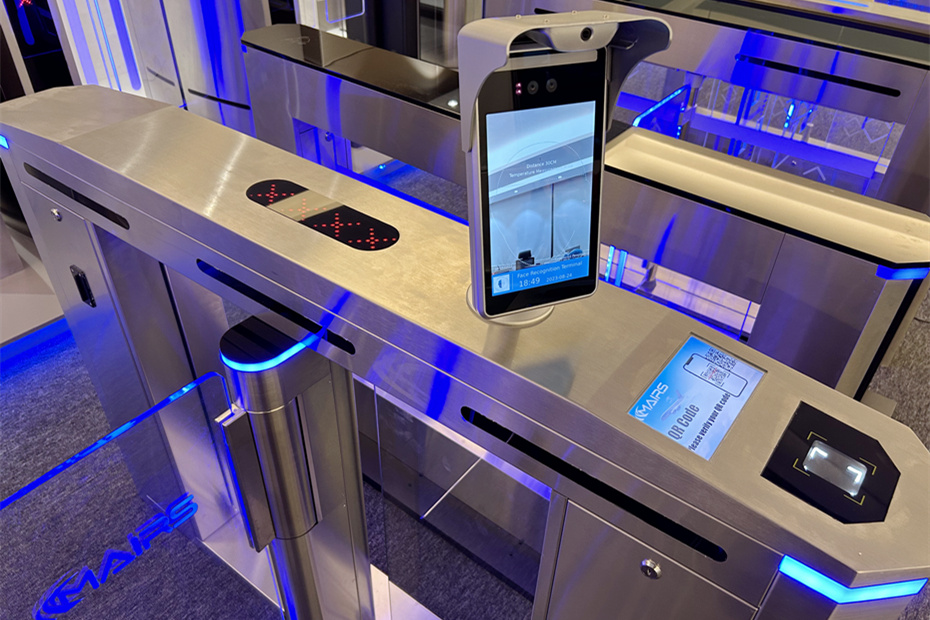
Face recognition turnstiles excel in handling express sorting, discrimination, and identification of multiple faces in specific application fields. The face recognition turnstile stands as a robust access control solution for pedestrian biometric entry turnstile gates. Unlike fingerprint verification or iris recognition which requires specific electronic devices or sensors, face recognition turnstiles utilize invisible light to capture facial image information. This method is discreet and not easily detectable.
Fingerprint turnstiles are widely utilized in biometric access control management, offering unique advantages despite having both strengths and weaknesses. The choice of a specific turnstile gate depends on the particular requirements of customers in different practical applications.
The fingerprint turnstile stands out as a convenient, reliable, non-invasive, and cost-effective biometric technology solution. Despite certain limitations, it holds significant potential for widespread application in various industries. Users must carefully consider their specific needs and circumstances when choosing a turnstile gate for access control management.
Advantages:
Compared to traditional turnstiles, the biometric turnstile has the following advantages:
Enhanced Security:
Biometric turnstiles provide a higher level of security compared to traditional turnstiles. Unique biological and behavioral traits, such as fingerprints, face recognition, or iris patterns, are difficult to forge or replicate, reducing the risk of unauthorized access.
Accuracy and Precision:
Biometric turnstiles offer high accuracy in identifying individuals. The use of distinct and unique biological features ensures precision in authentication, minimizing the chances of false positives or negatives.
Behavioral Characteristics Management:
Biometric technology allows for the management of human behavior characteristics. Access control systems can not only regulate access rights but also collect data on personnel density, frequency statistics, and trajectory tracking for comprehensive behavioral analysis.
Convenience:
Biometric identification is often more convenient than traditional methods. Users do not need to carry physical items such as keys or access cards, reducing the risk of loss or theft. Biometric data is inherently portable and can be accessed anytime and anywhere.
Unforgettable and Confidential:
Biometric traits, such as fingerprints or facial features, are unique to each individual and difficult to forget. This enhances the convenience of the identification process while maintaining a high level of confidentiality.
Anti-Counterfeiting Performance:
Biometric recognition technologies are known for their robust anti-counterfeiting performance. The difficulty in replicating or forging biological traits makes it a reliable method for authenticating individual identities.
Universality:
Biometric traits are universal, meaning that everyone possesses similar biological characteristics. This universality allows for widespread application across diverse populations.
Uniqueness:
The uniqueness of biometric features ensures that each individual can be distinguished accurately. This distinctiveness adds an extra layer of security to the identification process.
Permanence:
Biometric features exhibit permanence, meaning they remain relatively unchanged over time. This stability ensures the longevity and reliability of the biometric identification method.
Collectibility:
Biometric features must be easily collectible for practical application. Whether it’s fingerprint scanning, facial recognition, or other methods, the ease of obtaining biometric data is a crucial factor in the technology’s effectiveness.
Recognition Performance:
Biometric systems are evaluated based on their recognition performance, encompassing accuracy, speed, and stability. A reliable biometric device should achieve high recognition accuracy, operate swiftly, and maintain stability under various conditions.
User Acceptance:
The acceptance of biometric recognition methods by end users is essential. Factors such as ease of use, privacy concerns, and cultural acceptance contribute to the overall acceptance of the technology.
In conclusion, the use of biometric recognition technology is motivated by its unique combination of security, accuracy, convenience, and acceptance, making it a valuable solution for access control systems and other applications.
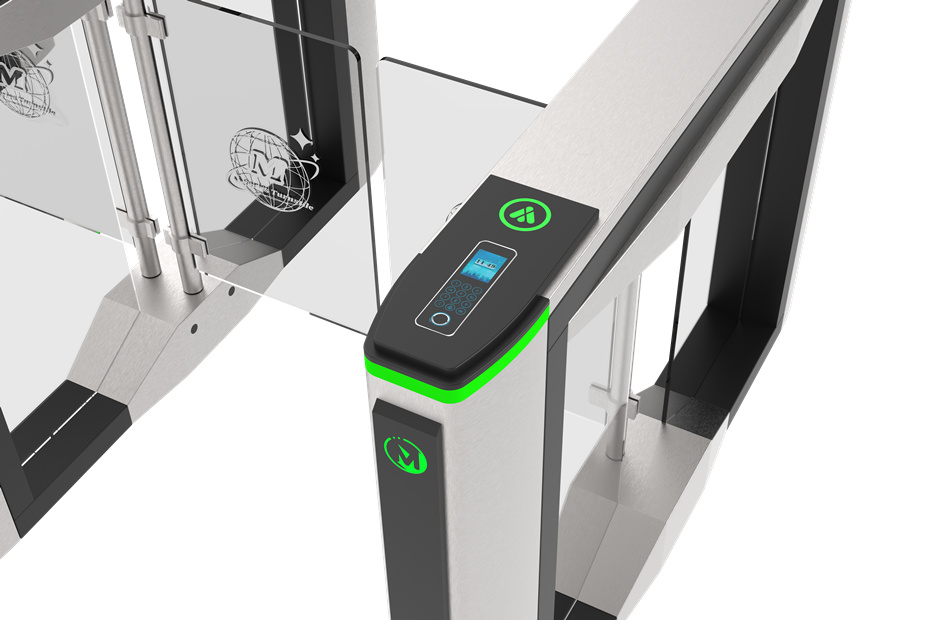
Purchasing suggestions:
Selection Suggestions for Biometric Turnstiles:
Biometric turnstiles have experienced rapid development in recent years, including advancements like fingerprint turnstiles and face recognition turnstiles. However, users often face confusion when selecting the most suitable technology for their needs. The following key factors should be considered when choosing a biometric turnstile:
User Acceptance:
User acceptance is paramount for any product solution. Understanding which biometric patterns are acceptable to users is crucial. For instance, concerns about hygiene and specific user identification requirements may lead to the rejection of fingerprint turnstiles. The rise of non-contact technology addresses such concerns, emphasizing the importance of aligning solutions with user preferences.
Biometric Turnstile Security:
As with the hidden dangers of network security, the popularity of biometric solutions attracts criminals attempting unauthorized access. Security is a critical consideration when choosing biometric turnstiles to safeguard against potential threats, unauthorized instructions, or direct attacks.
Accuracy:
Despite technological maturity, accuracy remains a fundamental customer need. Key indicators such as false acceptance rate (FRR), false alarm rate, recognition rate, and false rejection rate (FAR) help assess product accuracy. Factors like environmental light, recognition distance, and user alterations, such as makeup or cosmetic surgery, can impact the accuracy of face recognition.
Biometric Turnstile Cost:
Cost is a significant factor for users, often playing a decisive role in selecting the most efficient identification hardware. Balancing cost considerations with desired features is essential for making informed decisions.
Biometric Turnstile Environment:
The installation environment significantly influences product performance. Factors such as low light affecting face or iris recognition require careful consideration. Before choosing a biometric turnstile, environmental factors must be evaluated, and modifications can be made if necessary.
Trends:
Trends in biometric technology evolve over time. While fingerprint turnstiles were initially popular due to cost and technical constraints, recent years have witnessed a surge in biometric adoption, particularly in the financial and prison industries. Face recognition turnstiles and iris recognition turnstiles are gaining popularity in high-end projects due to their relatively high accuracy.
It’s important to note that these elements serve as general standards, as there is no one-size-fits-all model for different projects. Selecting the most appropriate biometric turnstile requires a comprehensive consideration of factors such as location, environment, and the application population.
All of our types of turnstiles (swing turnstile, flap barrier turnstile, tripod turnstile, speed gate turnstile, sliding turnstile, full height turnstile)can integrate with a variety of biometric devices. We can also provide a variety of biometric devices, such as fingerprint scanner and face recognition cameras, and easily integrate these biometric devices into our pedestrian turnstile gate, Usually, there are special customized biometric devices used on the pedestrian turnstile gate, which can better match and achieve more performance. In this way, it can also save space and look more beautiful.
If you need to buy any biometric turnstiles, please call us at: +86 1532-343-1686 or request a free estimate.
Basic function:
In various sectors such as offices, residential complexes, and shopping malls, biometric turnstiles serve multiple functions, including ensuring user-safe entry and exit, conducting personnel density statistics, tracking frequency, and analyzing pedestrian trajectories. Currently, biometric turnstiles have emerged as a promising development track in fields like smart campuses, intelligent transportation, and smart communities.
Fast passage:
Biometric gates are typically designed for fast passage, providing a convenient user experience. The authentication process is usually completed within a few seconds, which helps reduce user waiting time.
Prevent impersonation:
Biometric technology has high accuracy and can effectively prevent impersonation. The individual’s biological characteristics are unique, so biometric gates provide a more reliable means of identity verification.
Data recording and statistics:
Biometric gates are usually equipped with data recording and statistics functions to record user travel information, such as travel time, frequency, etc. These data help managers better understand user behavior, conduct operational analysis, and make decisions.
Durable Construction:
The biometric turnstile is constructed from stainless steel, undergoing various processes to achieve a novel and aesthetically pleasing appearance while ensuring robust durability.
Emergency opening function:
Biometric gates are usually designed with an emergency opening function to ensure that personnel can evacuate quickly and safely in emergencies.
Programmable Gate Control:
The gate control is programmable, offering users the flexibility to choose from multiple working modes. It allows for the configuration of one-way or two-way control, providing customizable settings based on user preferences.
Unified Electrical Interface:
Featuring a unified and standard external electrical interface, the biometric turnstile facilitates seamless connections with various reading and writing equipment. This design ensures easy system integration and compatibility.
Clear Traffic Indication:
The biometric turnstile includes a clear traffic indication function, offering visual prompts for the traffic status, and distinguishing between passable and forbidden states. This feature enhances user awareness and ensures smooth pedestrian flow.
In conclusion, the biometric turnstile goes beyond basic entry control, providing a robust and customizable solution with features tailored to modern security and access needs. Its applications extend to diverse environments, making it a valuable asset in the development of smart and secure spaces.
Application location:
Biometric turnstiles find widespread applications across various sectors, contributing to enhanced security, efficiency, and cost savings. Primarily used in stations, airports, customs, subway ticket checking, and examinations, these turnstiles ensure the smooth passage of passengers with valid tickets, ultimately improving overall work efficiency.
Moreover, the versatility of biometric turnstiles extends to fields such as office buildings, residential areas, cinemas, exhibition centers, libraries, stadiums, and tourist attractions, meeting both aesthetic and practical considerations for indoor and outdoor decoration design.
The broad applications of biometric turnstiles, specifically face recognition turnstiles, extend beyond traditional access control. These technologies play a pivotal role in modernizing security measures, improving efficiency, and creating more convenient and secure environments across various sectors.
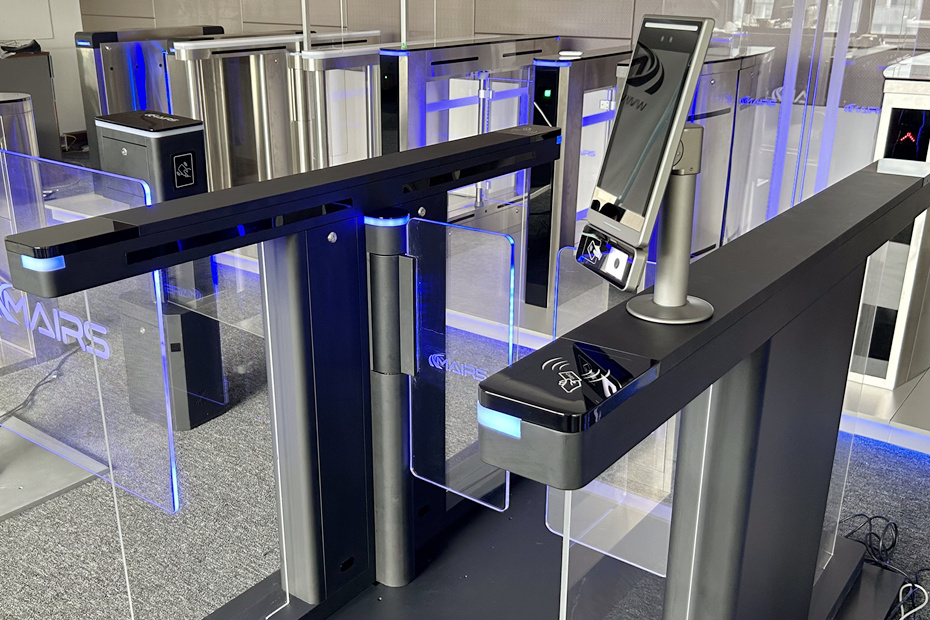
Types of Biometric Technology:
Biometric technology refers to the utilization of distinctive biological and behavioral features of the human body for the purpose of recognizing and authenticating individual identities. This technology encompasses various physiological characteristics, such as fingerprints, finger veins, palm prints, palm shape, face structure, iris, voiceprints, palm veins, DNA, and behavioral features like signatures and gait.
Biometric identification technology is a comprehensive approach that integrates diverse biometric sensors and principles of biostatistics. By closely examining the inherent physiological and behavioral traits unique to each individual, such as fingerprints, palm shape, iris patterns, veins, handwriting, voice, and gait, this technology aims to authenticate individual identities.
In essence, biometric technology serves as a solution for authentication based on human body characteristics. It has gained popularity as a verification method, particularly in intelligent pedestrian biometric turnstile access control systems. The core of biometrics lies in the acquisition of these biological characteristics, their conversion into digital information, storage in computer systems, and the application of reliable matching algorithms to verify and identify personal identity.
What are the common biometric technologies of biometric turnstiles? Let’s briefly introduce it.
Biometric technology is widely used, especially in the field of security. At present, the main biometric technologies include fingerprint recognition, face recognition, iris recognition, speech recognition, and signature recognition.
Fingerprint Identification:
Recognizes individuals based on the lines, details, and patterns of human fingerprints.
Widely used in pedestrian access turnstile gates for attendance and access control.
Advantages: Long history, mature technology, small equipment, and low cost.
Disadvantages: Contact is required, and issues like wear, dryness, and cleanliness of fingers can affect recognition.
Finger Vein Recognition:
Utilizes near-infrared radiation to capture images of living human finger veins for encoding and authentication.
Overcomes issues of copying or stealing as it requires a living finger vein.
High security and convenience with a recognition rate of about 99.99%.
Face Recognition:
Recognizes individuals based on facial features using cameras to capture and analyze facial shapes and contours.
Known for its convenience and ease of use but is sensitive to variations in brightness, angle, and facial expressions.
Challenges include changes in facial features and sensitivity to direct exposure to light.
Palmar Vein Recognition:
Captures image features of the palmar vein, which exists only in a living palm.
Recognizes individuals based on the geometric shape of the human hand, including length, width, thickness, and surface area of the palm.
High accuracy with a recognition time of about 1 second.
Iris Recognition:
Recognizes individuals based on the unique patterns in the iris, which remain stable after around the age of two.
Known for high accuracy, anti-deception, and no-contact features.
Challenges include expensive and complex iris image acquisition equipment.
Speech Recognition:
Analyzes the speaker’s voice and linguistic patterns for recognition based on the frequency of pronunciation.
Easy to use with a large distance range, but low accuracy and susceptibility to background noise and emotional factors.
Signature Recognition:
Analyzes handwriting of signatures, including pressure and speed, for identity confirmation.
Can be divided into online and offline signatures, with online signatures being more difficult to forge.
Challenges include susceptibility to mood, writing tools, and ease of forgery.
Each biometric technology has its own set of advantages and disadvantages, making them suitable for different applications. Fingerprint recognition is the most widely used, while face recognition is gaining popularity. Biometric turnstile gates often incorporate a combination of technologies to meet user requirements for attendance and security.

Video of Biometric turnstile:
The biometric turnstile is widely used in every corner of people’s lives. If you want to learn more about the biometric turnstile information, please refer to the following biometric turnstile demo:

